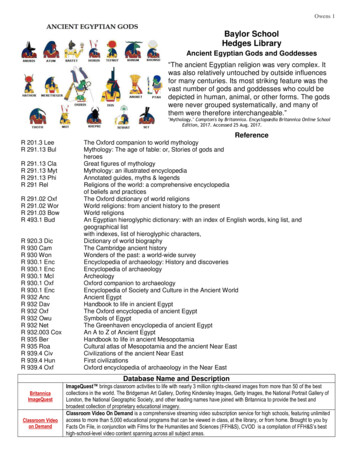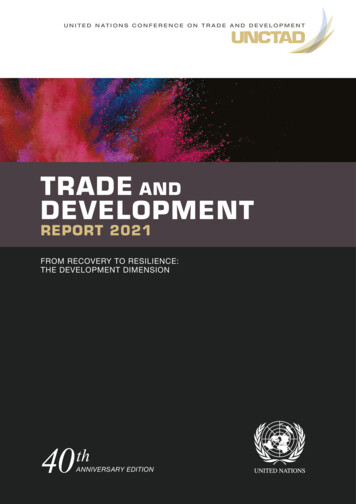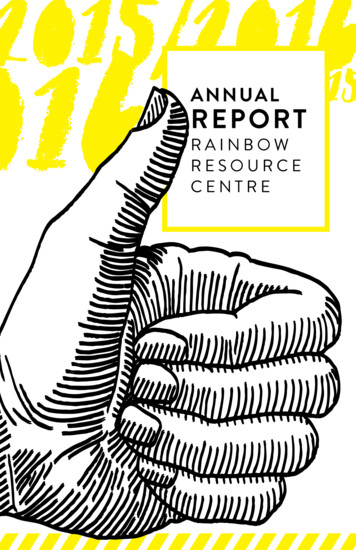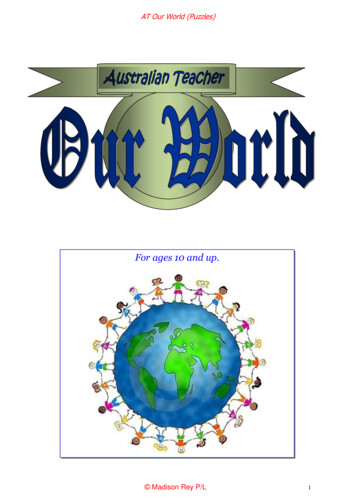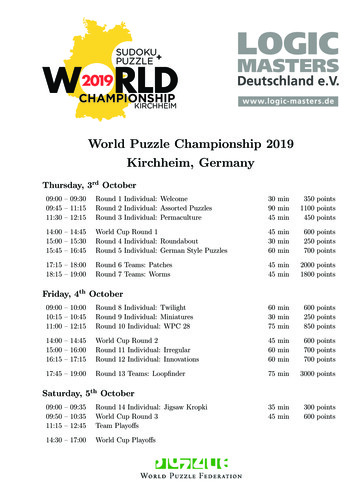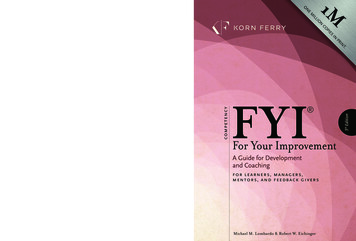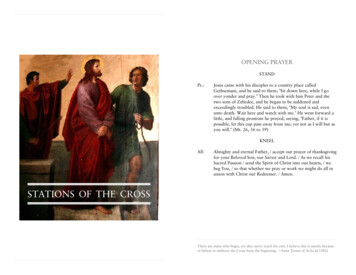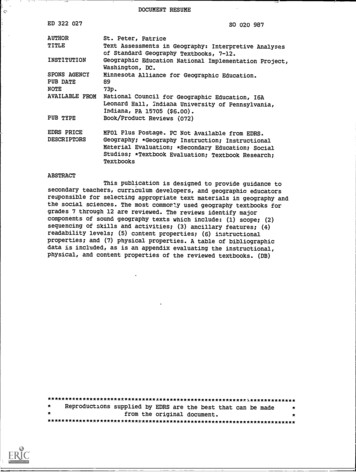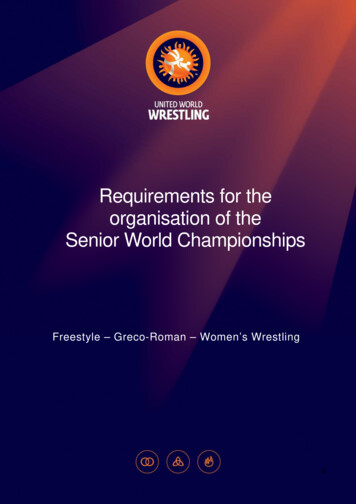
Transcription
World Development Report 2000/2001: Attacking Poverty (which follows twoother World Development Reports on poverty, in 1980 and 1990) arguesnevertheless that major reductions in all these dimensions of poverty are indeedpossible—that the interaction of markets, state institutions, and civil society canharness the forces of economic integration and technological change to serve theinterests of poor people and increase their share of society’s prosperity.1818 H Street, N.W.Washington, D.C. 20433, U.S.A.2000Actions are needed in three complementary areas: promoting economicopportunities for poor people through equitable growth, better access tomarkets, and expanded assets; facilitating empowerment by making stateinstitutions more responsive to poor people and removing social barriersthat exclude women, ethnic and racial groups, and the sociallydisadvantaged; and enhancing security by preventing and managingeconomywide shocks and providing mechanisms to reduce the sources ofvulnerability that poor people face. But actions by countries andcommunities will not be enough. Global actions need to complementnational and local initiatives to achieve maximum benefit for poor peoplethroughout the world.WORLD DEVELOPMENT REPORT /2001AT TA C K I N G P O V E R T YAt the start of a new century, poverty remains a global problem of hugeproportions. Of the world’s 6 billion people, 2.8 billion live on less than 2 aday and 1.2 billion on less than 1 a day. Eight of every 100 infants do not liveto see their fifth birthday. Nine of every 100 boys and 14 of every 100 girlswho reach school age do not attend school. Poverty is also evident in poorpeople’s lack of political power and voice and in their extreme vulnerability toill health, economic dislocation, personal violence, and natural disasters. Andthe scourge of HIV/AIDS, the frequency and brutality of civil conflicts, andrising disparities between rich countries and the developing world haveincreased the sense of deprivation and injustice for many.Telephone: 202 477 1234Facsimile: 202 477 6391Telex: MCI 64145 WORLDBANKMCI 248423 WORLDBANKInternet: www.worldbank.orgE-mail: books@worldbank.orgOxford University Press xHSKBTFy21 290zv*: :!: :!0-19-521129-4THEWORLDBANKOXFORDPublic Disclosure AuthorizedPage 1Public Disclosure Authorized3:32 PMPublic Disclosure Authorized8/2/00Public Disclosure AuthorizedWDR 2000 FINAL COVERWORLD DEVELOPMENT2000REPORT /200122684AT TA C K I N G P O V E RT Y
WORLD DEVELOPMENT2000REPORT /2001AT TA C K I N G POV E RT Y
Cover ArtVoyage to the New World, 1999. Mixed media on wood, by Manuel Cunjamá,Mexico. The images used to open the chapters are also taken from this painting andfrom three others by Cunjamá: Dialogue with the Universe, Magic Kite, and Lookingfor the Cosmic Balance.Manuel Cunjamá was born in 1971 in Tuxtla Gutiérrez, Chiapas. He began exhibitinghis work in Chiapas in 1992. Currently, Ana Quijano Gallery in Mexico City is representing Cunjamá in traveling exhibits in the United States. Cunjamá’s work is includedin the collection of the World Bank art program.In my work I seek and try to incorporate native symbols and elements that would take me toprehispanic issues and all that I consider useful to this effect I show it in my work.I use the sun, the moon, the night, and the universe as symbols representing the worry andanxiety of the human being for the wholeness surrounding him: The infinite.—Manuel CunjamáThe World Bank Art Program makes particular efforts to identify artists from developing nations and make their work available to a wider audience. The art program organizes exhibits, educational and cultural partnerships, competitions, artists’ projects, andsite-specific installations.
WORLD DEVELOPMENTREPORT 2000/2001AT TA C K I N G POV E RT YPublished for the W O R L D B A N KOXFORD UNIVERSITY PRESS
Oxford University PressOXFORD NEW YORK ATHENS AUCKLAND BANGKOKBOGOTA BUENOS AIRES CALCUTTA CAPE TOWN CHENNAIDAR ES SALAAM DELHI FLORENCE HONG KONG ISTANBULKARACHI KUALA LUMPUR MADRID MELBOURNE MEXICOCITY MUMBAI NAIROBI PARIS SÃO PAULO SINGAPORETAIPEI TOKYO TORONTO WARSAWand associated companies inBERLINIBADAN 2001 The International Bank for Reconstruction andDevelopment / The World Bank1818 H Street, N.W., Washington, D.C. 20433, U.S.A.Cover design and chapter openers by Tomoko Hirata.Published by Oxford University Press, Inc.200 Madison Avenue, New York, N.Y. 10016Oxford is a registered trademark of Oxford University Press.All rights reserved. No part of this publication may bereproduced, stored in a retrieval system, or transmitted, in anyform or by any means, electronic, mechanical, photocopying,recording, or otherwise, without the prior permission of OxfordUniversity Press.Manufactured in the United States of AmericaFirst printing September 2000This volume is a product of the staff of the World Bank, and thejudgments made herein do not necessarily reflect the views of itsBoard of Executive Directors or the countries they represent.The World Bank does not guarantee the accuracy of the dataincluded in this publication and accepts no responsibilitywhatsoever for any consequence of their use. The boundaries,colors, denominations, and other information shown on anymap in this volume do not imply on the part of the World Bankany judgment on the legal status of any territory or theendorsement or acceptance of such boundaries.ISBN 0-19-521598-2 clothboundISBN 0-19-521129-4 paperbackISSN 0163-5085Text printed on recycled paper that conforms to the AmericanStandard for Permanence of Paper for Printed Library MaterialZ39.48-1984.
ForewordPoverty amid plenty is the world’s greatest challenge. We at the Bank have made it our mission to fightpoverty with passion and professionalism, putting it atthe center of all the work we do. And we have recognized that successful development requires a comprehensive, multifaceted, and properly integrated mandate.This report seeks to expand the understanding ofpoverty and its causes and sets out actions to create aworld free of poverty in all its dimensions. It both buildson our past thinking and strategy and substantiallybroadens and deepens what we judge to be necessaryto meet the challenge of reducing poverty. It argues thatmajor reductions in human deprivation are indeedpossible, and that the forces of global integration andtechnological advance can and must be harnessed toserve the interests of poor people. Whether this occurswill depend on how markets, institutions, and societiesfunction—and on the choices for public action, globally, nationally, and locally.The report accepts the now established view ofpoverty as encompassing not only low income and consumption but also low achievement in education,health, nutrition, and other areas of human development. And based on what people say poverty meansto them, it expands this definition to include powerlessness and voicelessness, and vulnerability and fear.These dimensions of human deprivation emergedforcefully from our Voices of the Poor study, conductedas background for the report, which systematicallysought the views of more than 60,000 men and womenliving in poverty in 60 countries.These different dimensions of poverty interact inimportant ways. So do interventions to improve thewell-being of poor people. Increasing education leadsto better health outcomes. Improving health increasesincome-earning potential. Providing safety nets allowspoor people to engage in higher-risk, higher-return activities. And eliminating discrimination against women,ethnic minorities, and other disadvantaged groupsboth directly improves their well-being and enhancestheir ability to increase their incomes.The 20th century saw great progress in reducingpoverty and improving well-being. In the past fourdecades life expectancy in the developing world increased 20 years on average, the infant mortality rate fellmore than half, and fertility rates declined by almost half.In the past two decades net primary school enrollmentin developing countries increased by 13 percent. BetweenV
viworld development report 2000 20011965 and 1998 average incomes more than doubled in developing countries, and in 1990–98 alone the number ofpeople in extreme poverty fell by 78 million.But at the start of a new century, poverty remains aglobal problem of huge proportions. Of the world’s 6 billion people, 2.8 billion live on less than 2 a day, and 1.2billion on less than 1 a day. Six infants of every 100 donot see their first birthday, and 8 do not survive to theirfifth. Of those who do reach school age, 9 boys in 100,and 14 girls, do not go to primary school.These broad trends conceal extraordinary diversity inexperience in different parts of the world—and largevariations among regions, with some seeing advances, andothers setbacks, in crucial nonincome measures of poverty.Widening global disparities have increased the sense ofdeprivation and injustice for many. And social mobilityand equal opportunity remain alien concepts for far toomany people.Future demographic changes will add to the challenge we face in further reducing poverty. In the next 25years roughly 2 billion people will be added to the world’spopulation—almost all of them (an estimated 97 percent)in developing countries, putting tremendous pressureon these societies. Clearly, much must be done to reducepoverty in its multiple dimensions and to promote humanfreedom, today and in the years ahead.While current and future challenges remain daunting, we enter the new millennium with a better understanding of development. We have learned that traditionalelements of strategies to foster growth—macroeconomicstability and market-friendly reforms—are essential forreducing poverty. But we now also recognize the needfor much more emphasis on laying the institutional andsocial foundations for the development process and onmanaging vulnerability and encouraging participation toensure inclusive growth. And while domestic action iscritical, we have also learned that global developmentsexert a potent influence on processes of change at nationaland local levels—and that global action is central topoverty reduction. We have taken a fresh look at our workthrough the Comprehensive Development Framework,which converges with the views and findings of this report.Based on its analysis of ideas and experience, this report recommends actions in three areas: Promoting opportunity: Expanding economic opportunity for poor people by stimulating overall growthand by building up their assets (such as land and ed-ucation) and increasing the returns on these assets,through a combination of market and nonmarketactions. Facilitating empowerment: Making state institutionsmore accountable and responsive to poor people,strengthening the participation of poor people in political processes and local decisionmaking, and removing the social barriers that result from distinctionsof gender, ethnicity, race, religion, and social status. Enhancing security: Reducing poor people’s vulnerabilityto ill health, economic shocks, crop failure, policyinduced dislocations, natural disasters, and violence,as well as helping them cope with adverse shockswhen they occur. A big part of this is ensuring that effective safety nets are in place to mitigate the impactof personal and national calamities.Advances in the three areas are fundamentallycomplementary—each is important in its own right andeach enhances the others. Drawing on this framework,countries need to develop their own poverty reductionstrategies, in a manner consistent with preservation ofculture. Decisions on priorities must be made at the national level, reflecting national priorities. But actionmust also take place with local leadership and ownership,reflecting local realities. There is no simple, universalblueprint.Action at the local and national levels is not enough,however. The evidence of the past decade vividly revealsthe importance of global action, both to ensure that theopportunities from global integration and technologicaladvance benefit poor people and to manage the risks ofinsecurity and exclusion that may result from globalchange. Five actions are key: Promoting global financial stability and opening themarkets of rich countries to the agricultural goods,manufactures, and services of poor countries. Bridging the digital and knowledge divides, thusbringing technology and information to peoplethroughout the world. Providing financial and nonfinancial resources for international public goods, especially medical and agricultural research. Increasing aid and debt relief to help countries takeactions to end poverty, within a comprehensive framework that puts countries themselves—not externalaid agencies—at the center of the design of development strategy and ensures that external resources areused effectively to support the reduction of poverty.
forewordGiving a voice to poor countries and poor people inglobal forums, including through international linkswith organizations of poor people.Public action must be driven by a commitment topoverty reduction. The public and private sectors must worktogether—along with civil society—both within and between countries. While we have much to learn, and whilethe world continues to change rapidly, the experiences re- viiviewed in this report show that there is now sufficient understanding to make actions to reduce poverty truly effective.We are living in a time in which the efforts and issues surrounding poverty reduction are subject to great scrutiny.In the aftermath of protests and in the midst of controversy, this report offers real substance to the public debateand brings the dialogue to the foreground, where indeedthe goal of a world without poverty belongs.James D. WolfensohnPresidentThe World BankAugust 2000This report has been prepared by a team led by Ravi Kanbur (director of the team until May 2000) and Nora Lustig (deputy director until May 2000 and director since). Monica Das Gupta, Christiaan Grootaert, Victoria Kwakwa, Christina Malmberg Calvo,and Kevin Morrison served as full-time team members. Other core team members included Alice Sindzingre, Michael Woolcock,and Zainal Yusof. Major contributions to chapters were made by Homi Kharas, Aart Kraay, Peter Lanjouw, and Giovanna Prennushi as well as by Benu Bidani, William Easterly, Enrique Flores, Hélène Grandvoinnet, Richard Newfarmer, Gi-Taik Oh, andMattia Romani. Michael Walton, in his capacity as director, Poverty Reduction, worked closely with the team throughout theprocess. Shanka Chakraborty and Shahin Yaqub assisted the team. Interns from the Washington Center provided other valuableassistance. The work was carried out under the general direction of Jozef Ritzen and Joseph E. Stiglitz and, in the final stages,Nicholas Stern. The World Bank Development Data Group was responsible for the Selected World Development Indicators.Bruce Ross-Larson and Meta de Coquereaumont were the principal editors of the report.The team was advised by Anthony Atkinson, Anthony Bebbington, Nancy Birdsall, François Bourguignon, AngusDeaton, Alain de Janvry, Yujiro Hayami, Emmanuel Jimenez, Grzegorz Kolodko, Michael Lipton, Lant Pritchett,Martin Ravallion, Amartya Sen, Lyn Squire, T. N. Srinivasan, and Mariano Tommasi. Deepa Narayan led the Voices ofthe Poor study. Vinod Thomas led the Quality of Growth study, which complements the work of this report. Ariel Fiszbeinled the organization of the consultation process. Much insight was gained from the papers and discussions at the Summer Workshop held in Washington, D.C., on 6–10 July 1999, as well as from the background papers prepared for thisreport. The authors, commentators, and participants, as well as the background papers, are listed in the bibliographicnote. Many others inside and outside the World Bank provided helpful comments and other contributions; their namesare also listed in the bibliographic note.A wide range of consultations with academics, grassroots leaders, NGOs, private sector representatives, and policymakerswere undertaken for this report, from initial outline to final draft. Thanks go to all the public institutions and civil societyorganizations that helped make these consultations possible, as well as the organizers and participants, whose contributionsgreatly enriched this report. Particular thanks go to the Bretton Woods Project and the New Policy Institute in the UnitedKingdom, which moderated the electronic discussion on the Web draft, and to all who submitted comments: 424 contributions were posted from 44 countries (44 percent from developing countries). Consultations were held in Argentina (BuenosAires), Bangladesh (Dhaka), Canada (Ottawa), Chile (Santiago), Denmark (Copenhagen), Egypt (Cairo), Ethiopia (AddisAbaba), France (Paris), Germany (Berlin), Guatemala (Antigua), Hungary (Budapest), India (Ahmedabad, New Delhi),Japan (Tokyo), Malaysia (Kuala Lumpur), Morocco (Marrakech), Russia (Moscow), Senegal (Dakar), South Africa (Johannesburg), Sweden (Stockholm), the United Kingdom (Brighton, London), the United States (Boston, New York, Wash-
viiiworld development report 2000 2001ington, D.C.), and Vietnam (Hanoi). Consultations were also held at and in conjunction with the International MonetaryFund, the regional development banks, and several United Nations organizations.The preparation of background papers and the convening of several workshops were supported by the governments ofCanada, Denmark, France, Germany, Japan, the Netherlands, Sweden, Switzerland, the United Kingdom, and the UnitedStates; the MacArthur Foundation; Cornell University; and the Development Policy Forum of the German Foundationfor International Development. The Voices of the Poor study was supported by the MacArthur Foundation, CornellUniversity, the U.K. Department for International Development, and the Swedish International Development Cooperation Agency; and several of the country studies were partially or fully financed by the NGOs that conducted the research.Rebecca Sugui served as executive assistant to the team, and Maribel Flewitt, Shannon Hendrickson, Khin-U Khine,Rudeewan Laohakittikul, Jimena Luna, Nelly Obias, Gracie Ochieng, Leila Search, and Robert Simms as team assistants.Maria D. Ameal served as administrative officer. Nacer Megherbi and Edith Thomas provided technical support.Book copyediting and production were by Fiona Blackshaw, Garrett Cruce, Terry Fischer, Wendy Guyette, DaphneLevitas, Molly Lohman, Megan Klose, Jessica Saval, and Alison Strong of Communications Development. Book design,editing, and production were managed by Jamila Abdelghani, Catherine Hudson, Brett Kravitz, Nancy Lammers, BrendaMejia, Randi Park and Betty Sun of the of the World Bank’s Office of the Publisher. Artemis Zenetou, manager and curator of the World Bank Art Program, and her staff were instrumental in the use of the artwork in the book. Tomoko Hirata designed the cover and the chapter openers.Ravi Kanbur is T. H. Lee Professor of World Affairs in the Department of Agricultural, Resource, and Managerial Economics,Cornell University, Ithaca, New York. Nora Lustig is senior advisor and chief of the Poverty and Inequality Advisory Unitof the Inter-American Development Bank. Kevin Morrison is a fellow at the Overseas Development Council. Alice Sindzingre is a researcher at the Centre National de la Recherche Scientifique (CNRS) in Paris and an associate researcher at theCentre d’Etude d’Afrique Noire (CEAN) in Bordeaux. Zainal Yusof is deputy director general of the Institute of Strategicand International Studies (ISIS) in Kuala Lumpur, Malaysia. The World Bank is grateful to the six institutions for making possible their participation in the preparation of the report.The many contributors to the report may not endorse every viewpoint or assertion in it, and they bear no responsibility for any errors that remain.
ContentsOverview Attacking Poverty: Opportunity, Empowerment, and SecurityBasrabai’s storyPoverty in an unequal worldA strategy for poverty reductionFrom strategy to actionWorking together to fight poverty1236712Part I FrameworkChapter 1 The Nature and Evolution of Poverty15Poverty’s many dimensionsMeasuring poverty in its multiple dimensionsThe evolution of poverty151621Chapter 2 Causes of Poverty and a Framework for Action31The causes of povertyA framework for action3437Part II OpportunityChapter 3 Growth, Inequality, and Poverty45Economic growth and poverty reductionWhat drives economic growth?Why are similar rates of growth associated with different rates of poverty reduction?Economic growth and nonincome poverty46495257Chapter 4 Making Markets Work Better for Poor People61Have market reforms delivered growth?Have market reforms delivered benefits to poor people?Making markets do more for poor people626472Chapter 5 Expanding Poor People’s Assets and Tackling Inequalities77Assets and their synergiesPublic action to facilitate the accumulation of assetsRedistributing public spendingInstitutional reforms for effective delivery: governance, markets, and competitionParticipation: choice, monitoring, and accountabilityComplementarities in public action777880858893IX
xworld development report 2000 2001Part III EmpowermentChapter 6 Making State Institutions More Responsive to Poor People99Public administration and poverty reductionPoor people and the rule of lawHow can decentralization be made pro-poor?The politics of poverty reduction: pro-poor coalitionsPolitical regimes and poverty99102106108112Chapter 7 Removing Social Barriers and Building Social Institutions117Gender discrimination and povertySocial stratification and povertySocial fragmentation and conflictBuilding social institutions and social capital117123126128Part IV SecurityChapter 8 Helping Poor People Manage Risk135A typology of risksThe nature and magnitude of vulnerabilityResponses to risk by households and communitiesPolicy responses for improving risk management136138140146Chapter 9 Managing Economic Crises and Natural Disasters161Preventing and coping with economic crisesReducing vulnerability to natural disasters161170Part V International ActionsChapter 10 Harnessing Global Forces for Poor People179Expanding market access in high-income countriesReducing the risk of economic crisesProducing pro-poor international public goodsEnsuring a voice for poor people in global forums179180181185Chapter 11 Reforming Development Cooperation to Attack Poverty189Making aid more effective in reducing povertyRelieving the debt burden of poor countries192200Bibliographic NoteSelected World Development Indicators205267Boxes121.11.2The voices of the poorA better world for all: international development goalsPoverty in the voices of poor peopleMeasuring income poverty: 1899 and 1998351617
17.2Measuring vulnerabilityMeasuring voice and power using participatory methodsMeasuring governance: participatory methods and cross-country surveysMultidimensionality: dealing with aggregationUganda’s poverty reduction goalsTracking poverty in India during the 1990sOn interacting with state institutions: the voices of the poorPreventing famines: the local press mattersAttacking poverty in VietnamPopulation, growth, and povertyHow war devastates poor peopleDivergence and worldwide income inequalityInequality trends and poverty reductionWhat makes growth pro-poor in India?Complex patterns of distributional change in three economiesDiversification and migration in rural ChinaRedistribution can be good for efficiencyThe Washington consensusWhy do reforms sometimes fail?Agricultural reforms in Chile and China help small farmersLand markets and poor peasants in MexicoListening to farmers in ZambiaAttacking poverty with informationInteractions between human and physical capitalLinks between the environment and healthWin-win policies in the health sectorLocked out by health and education feesMexico’s Progresa: paying parents to send children to schoolSome general principles on how to design subsidiesEffective public-private partnership in immunizationLocal entrepreneurs increase access to telecommunications servicesLocal participation in Nicaragua’s decentralized education systemSingle-sector and multisector arrangements for improving rural roads in ZambiaRejuvenating India’s forests through joint actionA new approach to land reform in BrazilWest African businesses pioneer water and sanitation services for the urban poorSustainable water and sanitation for Brazil’s urban poorPoor people are often harassed by public officialsLawlessness contributes to povertyLegal service organizations help poor people gain access to the protections of the legal systemCommunity monitoring can reduce environmental pollutionNational coalitions against communicable diseases in the WestNGOs can help mobilize and empower communitiesPolitics and poverty in OECD countriesThe evolution of civil society and state reform in MexicoMaking land titling less gender biased in Latin AmericaUsing subsidies to close gender gaps in 110114115121122
xiiworld development report 2000 2001Boxes (continued)7.3 Toward stronger female voice in policymaking: women’s budget initiatives in southern Africa7.4 Using development programs to break the power of agrarian elites:a case study from eastern Uttar Pradesh, India7.5 Discrimination is psychologically devastating7.6 Using affirmative action against caste-based discrimination in India7.7 Ethnic divisions and civil conflict7.8 How does social capital affect development?7.9 The federation of comedores in Peru: the creation of linking social capital7.10 Mobilizing and creating social capital in development projects8.1 Poor people’s exposure to risk8.2 AIDS and poverty8.3 Some key terms: risk, risk exposure, and vulnerability8.4 Managing risk: the modular approach to social safety nets8.5 Is targeting by the community a good idea?8.6 Insurance options for the informal sector8.7 Two universal health insurance systems: Costa Rica and Singapore8.8 Social pensions in Chile and Namibia8.9 Principles of successful workfare programs8.10 The Eritrean Community Development Fund8.11 The Self-Employed Women’s Association of India9.1 Providing social protection in response to crisis in the Republic of Korea9.2 Public expenditure reviews to assess the impact of fiscal retrenchment on poor people9.3 Protecting poor people during fiscal adjustment: Peru’s Fiscal Prudence and Transparency Law9.4 Mitigation is the cornerstone of emergency management in the United States9.5 Mitigating the risks of natural catastrophes: lessons from the 1999 earthquakes in Turkey9.6 Turning reconstruction into risk mitigation with the help of a local NGO9.7 Mitigating risk with catastrophe bonds9.8 Sharing the costs of catastrophes: the Mexican fund for natural disasters9.9 Involving communitities in postdisaster reconstruction: lessonsfrom the Maharashtra Emergency Earthquake Rehabilitation Program10.1 A success story: the fight against river blindness in Africa10.2 Research, maize, and pigs in rural Guizhou10.3 Most biotechnology patents are private10.4 The Global Environment Facility: a model for developing country participation11.1 Learning about the consultative process through the Comprehensive Development Framework11.2 The new poverty reduction strategy initiative11.3 Sectorwide development cooperation11.4 The common pool for development cooperation11.5 Assessing country policies and institutions11.6 How aid can help in countries with a weak policy environment11.7 The Enhanced Heavily Indebted Poor Countries Debt Relief Initiative11.8 How debt relief fits into a poverty reduction strategy: Uganda’s Poverty Action 195195197197198199201204Figures123Where the developing world’s poor liveWhere poverty has fallen, and where it has notInfant mortality rates vary widely across the world444
1.311.411.511.611.7Poverty in the developing world is shifting toward South Asia and Sub-Saharan AfricaPoverty shows a strong link with economic contractions and expansionsIn general, the wealthier a country, the lower the incidence of povertyHealth indicators improve as incomes risePoverty trends tracked growth trends in the 1980s and 1990sEconomic growth was a force for poverty reduction in the 1980s and 1990s . . .Inequality varied widely in the 1980s and 1990s but showed no systematic association with growthInitial inequalities influence the pace of poverty reductionAcross countries, the ratio of female to male literacy rises with per capita incomeIndications of successful policy reforms in the developing worldReforms delivered growth in Latin America, although the gains variedThe gap between skilled and unskilled wages widened in MexicoMerit-based recruitment in government is associated with less corruption and bureaucratic delayCorruption is a regressive taxBetter rule of law is associated with higher per capita incomeDecentralization lowers the cost of raising the income of poor people in South AfricaState-community coalitions can foster rapid development and better service deliveryGood political and administrative institutions go hand in hand with economic growthClosing the gender gap in schooling more rapidly would boost economic growthTrends in female education and life expectancy reflect increasing equality between women and menMinority groups in Vietnam have less access to services than nonminoritiesEthnic diversity is associated with violence where institutional quality is lowPrivate trans
Dialogue with the Universe, Magic Kite, and. Looking for the Cosmic Balance. Manuel Cunjamá was born in 1971 in Tuxtla Gutiérrez, Chiapas. He began exhibiting his work in Chiapas in 1992. Currently, Ana Quijano Gallery in Mexico City is repre-senting Cunjamá in traveling exhibits in the United States. Cunjamá's work is included
